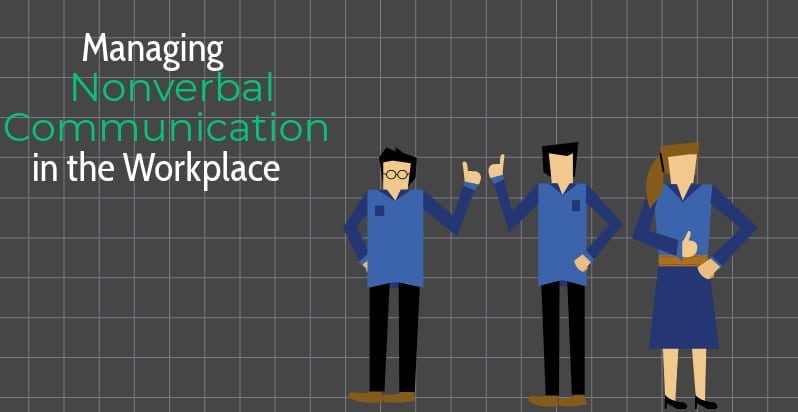
Managing Nonverbal Communication in the Workplace
Nonverbal communication refers to the expression of signals or messages via gestures, facial expressions, and body language. Almost 75% of all communication is non-verbal. Eye contact, the speed of voice, posture, and stance all contribute to the message we send and receive when communicating.
Hence, nonverbal communication is just as important as verbal communication when it comes to workplace relationships. Both managers and employees should pay attention to the way in which they communicate with their bodies, as it can greatly affect the message conveyed.
The Significance of Nonverbal Communication in the Workplace
Susanne Jones, Associate Professor of Communication Studies at the University of Minnesota, explains that employees use nonverbal cues as a tool to make judgment calls about their colleagues. Furthermore, managers can use these cues to internet staff performance. For example, the newest staff member may receive the message that the manager doesn’t like him because they keep their distance and avoids eye contact. Unbeknownst to the new employee, the manager is simply shy. This kind of misinterpretation of nonverbal signals in common, and can have harmful effects in certain scenarios.
How Nonverbal Cues Communicate
Just as different words communicate different messages, varying physical cues send certain messages. Some of these include:
-
Eye Contact
Eye contact is hugely important – research in the Harvard Business Review notes that a person can quite confidently gauge another’s emotions simply from the look in their eyes. Furthermore, eye contact is crucial in order to foster a connection. In a job interview, for example, someone who maintains eye contact and blinks in regular intervals is seen as confident and alert.
-
Facial Expressions
We can figure out how someone is feeling based on their facial expressions. We can even tell if someone is smiling when we can only hear their voice but not see their face. Smiling communicates warmth and connectedness.
-
Posture
The way someone’s body is positioned also communicates certain messages. If someone is sitting slumped, with their armed folded, we tend to feel far less connected to them. Someone whose arms are open, is nodding, and smiling, sends a much more open and connected nonverbal cue. In a job interview, for example, patting your hair or shirt sends a positive signal, whereas fidgeting sends the message that you’re nervous.
-
Tone of voice
The tone of voice in which we speak often sheds just as much light on how we’re feeling as the words themselves – sometimes even more. Talking loudly and quickly connotes aggression, whereas speaking calmly and articulately connotes confidence.
-
Breath
Even the way in which we’re breathing sends a message. When someone is stressed or annoyed, their breathing quickens. When someone is tired, they tend to sigh.
-
Clothing
The way in which we dress also communicates a certain message. That is not to say you should limit your personality in order to fit in to the workplace. However, keeping your appearance clean and tidy lets management know that you mean business.
-
Physical Space
This refers to the amount of distance between people when talking and working, but also the physical surroundings of the workplace – the distance between desks, and the size of certain offices speak powerful messages.
Nonverbal Communication and Power
CEOs and managers need to be particularly careful when it comes to their nonverbal communication cues. Associate Professor Jones explains that the way in which CEOs and managers communicate their power has great effects on workplace productivity. Often, people in these positions already communicate their power by possessing a larger office or desk space. If a manager sends an email instead of communicating face-to-face, this depersonalises the communication and makes employees feel distant. Furthermore, if a manager does call an employee in for a meeting, but sits them in a distant seat, this also sends a negative message. Those in management positions should ensure to maintain eye contact when talking to employees, not physically distance themselves in meetings or in office location, and should keep their posture open and composed.
Nonverbal Communication and Employees
To secure the job you’re seeking, ensure that your nonverbal cues in the interview say confidence – open stance with upright posture, clean and tidy outfit, a big smile, lots of eye contact, and a calm and collected tone of voice. Once you’ve got the job, it pays to take note of the way in which other employees interact. Pay attention to the pace in which employees move around the office, the physical distance between offices or desks, the outfits worn, and the level of warmth between colleagues. This is a good way to gauge what is, and isn’t considered acceptable in this work space.
Nonverbal Communication and Customers/Clients
Meeting with people from outside your organisation can present a unique challenge when it comes to nonverbal communication. In these scenarios, it’s important to be switched on at all times. A new client may say that the contract terms are okay, but their tone of voice and facial expression may be saying otherwise. Furthermore, you could be very excited about meeting the new clients, however you stayed up late last night and your fatigue is causing you to slump in your chair. The client will most likely interpret this as disinterest. These small nuances may be the difference between landing the new client, or loosing them.
Nonverbal cues are key to all aspects of workplace communication. Whether you’re a CEO communicating with an employee, a potential employee in a job interview, or a manager meeting with a new client, it’s vital to pay attention to the way in which our bodies send signals.